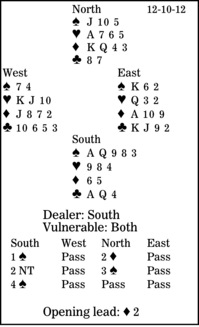Bridge column, December 10: The basics of defense and declarer play

In this deal from the book, South is in four spades. West leads the diamond two. East takes dummy's queen with his ace and shifts to the club two. How should declarer continue?
There is no bidding given for any deal. To reach four spades is very aggressive; stopping in three spades would be normal. Here, if three spades is nonforcing (as North wishes), South should pass with his minimum opening.
When in a suit contract, declarer should start by counting the losers in his hand. Here, given that East had the diamond ace, South must lose two hearts and one diamond. He might also concede as many as one spade and two clubs. To get home, both black-suit finesses must be winning and a club loser must be ruffed on the board.
At trick two, South puts in his club queen. When it holds, he cashes the club ace, and ruffs the club four. Now that he is on the board, he runs the spade jack (assuming East does not cover, of course). When that wins, declarer continues with the spade 10 and (again assuming East does not cover) overtakes with his queen, cashes the spade ace, and concedes those three tricks.
** ** **
COPYRIGHT: 2012, UNITED FEATURE SYNDICATE
DISTRIBUTED BY UNIVERSAL UCLICK FOR UFS

